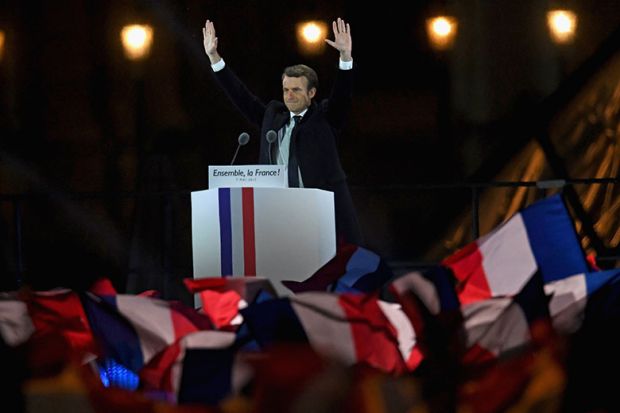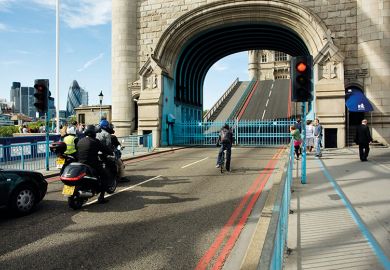Change is tricky. It’s difficult for all involved. And for higher education, change is rapidly becoming the norm as we continually seek to improve, enhance, streamline, reconfigure and rethink in order to deliver an even better deal for our students, our universities and for the local, regional, national and international communities.
It feels as if nothing – and no one – is beyond the reach of change; many in the UK sector would say that the past couple of years have seen more change in higher education than ever before. It is unprecedented. Therefore, as a higher education leader I am always looking for new models that may help us along in our processes of change; different perspectives on change that may bring a refreshing approach to one of the hardest things an individual or an organisation may have to engage with.
So I have been following with interest the astonishing political events in France over recent months, which have witnessed the truly remarkable rise to power of Emmanuel Macron, the new president-elect of France, having operated in relative obscurity little more than a year ago. In my view this represents a spectacular "management of change" programme on a significant scale, which is surely something to pause and reflect on.
Just how did he do it? How did he create something out of nothing in just 12 months? How did he defeat the organised mainstream political parties to sweep to power with a sizeable majority? How did he convince two thirds of those who voted to back him? And what can we learn from Macron’s approach, not only in relation to how political elections may be won and lost but also perhaps in relation to how to mobilise support for change on a smaller scale in our own communities, universities, even departments?
My interpretation of recent media analysis suggests that Macron’s success is down to some fairly easily identifiable factors. Firstly, he was able to step into a space unexpectedly vacated because of public disillusion with the status quo, further exacerbated by general disquiet in relation to the behaviour of certain politicians. Macron seized the moment.
But this wasn’t just brazen opportunism, rather he knew that he had to do things differently; he needed a game-changing approach. So, as we know, he tried something brand new and established En Marche! just 13 months before the election. The movement began with the "Grande March" – a gathering to mobilise his activists, who although hungry for change were inexperienced. So Macron channelled their enthusiasm and trained volunteers to knock on doors and carry out interviews with voters.
This huge data collection exercise then provided a robust evidence-base that would inform policy development, as well as providing a framework for early, meaningful engagement with the movement.
But secondly, Macron promoted a positive message and created a profile that resonated with people who were desperate for something new. Furthermore, he did not focus on himself, on what he would do for France; rather, he focused upon the people and the opportunities that would be created for them. He used the prevailing pessimism that had gripped France to his advantage by focusing instead on optimism and hope; his rallies would often have a backdrop of pop music, bright lights and high energy levels.
This was in stark contrast to his main rival Marine Le Pen, whose message focused on the problems faced by France in relation to immigration, the EU and "the system" generally. Le Pen’s focus was a negative one, which sought to capitalise on a latent feeling of fear, gloom and pessimism, but which clearly backfired in relation to votes.
So what can we in higher education learn from Macron’s approach to managing and mobilising change?
Well, on closer inspection we may recognise some of the steps from John Kotter’s legendary eight-step change process. Briefly, the first part of Kotter’s process involves creating a sense of urgency, building a change coalition and creating and communicating a vision for change. And I think we can see these steps mirrored in Macron’s approach.
But the key aspect of Macron’s approach that clinches it for me is the unwavering focus on a positive message; a message of hope and opportunity that is unequivocally forward thinking and that assumes a spirit of collaboration and partnership, rather than an approach predicated upon fear and coercion.
But now the hard work starts for Macron and it is the same for any of us involved in change programmes. Obstacles will be put in the new president’s way and he will have to think of creative ways to overcome them. Certain key members of the establishment and even the population more generally may feel marginalised and side-lined when faced with a leadership style that tries to view things differently; he will have to develop new approaches to public engagement.
Paying homage to Kotter, the new president will need to identify some "short-term wins" in order to build confidence among both followers and sceptics alike. He will need to keep momentum going, building on what has gone well and identifying what needs to further improve. And finally, he will need to achieve what every change leader wishes for and aspires to see – change anchored in culture.
The journey of change is difficult. It is hard. It affects individual lives and wider communities. Leaders of change are not perfect and may stumble along the way. But I have certainly taken courage from Emmanuel Macron’s approach: seize the moment, harness enthusiasm, have the courage to take a new approach and, crucially, bring a message that is positive, hopeful and focused on opportunity for all those involved.
Claire Taylor is deputy vice-chancellor and professor of education at Wrexham Glyndŵr University.




